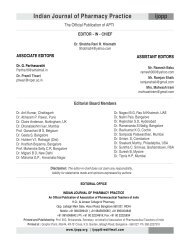Oct-Dec, 2011 - Indian Journal of Pharmacy Practice
Oct-Dec, 2011 - Indian Journal of Pharmacy Practice
Oct-Dec, 2011 - Indian Journal of Pharmacy Practice
- No tags were found...
Create successful ePaper yourself
Turn your PDF publications into a flip-book with our unique Google optimized e-Paper software.
Shobha C - Poison Information Center-An Overview <strong>of</strong> its Significance, Organization and FunctioningOrganisation <strong>of</strong> Poison Information CenterThe organisation pattern <strong>of</strong> PIC should be based onanticipated 'ideal human exposure call volume'. Majority <strong>of</strong>PICs are situated in the hospital and connected to the public13health service <strong>of</strong> the country at national or regional level.Networking with all other existing PICs that are integratedwith regional PICs and national PIC in for better utilization <strong>of</strong>available resources and developing national database on13,14poisoning. It is also important to have analyticallaboratories to provide analytical services for themanagement <strong>of</strong> poisoned patients. Financial support is alsoessential to operate PIC effectively. The government shouldcommit its resources and <strong>of</strong>fer for financial support to PICs,as it is concerned with public health. The centre can alsoremain independent and autonomous by generating its ownrevenue.Staff:Table 1: Roles <strong>of</strong> poison information centerRoles <strong>of</strong> poison information centerProvision <strong>of</strong> poison information servicesManagement <strong>of</strong> poisoning casesToxicological analytical servicesToxicovigilanceConducting education and training <strong>of</strong> healthcare pr<strong>of</strong>essionalsConducting education and awareness program for publicregarding prevention <strong>of</strong> accidental poisoningDevelopment <strong>of</strong> treatment protocols for poison managementThe PIC is usually staffed by a physician (Medical director), apharmacist (Technical director), an administrator, at least onemedical toxicologist, adequate number <strong>of</strong> poison informationspecialists and a secretary. Poison information specialist maybe a pharmacist/nurse/medical scientist. The poisoninformation specialist must be health care pr<strong>of</strong>essionals inorder to interact freely with physicians while providingconsultative services and interpret basic toxicologyinformation. Pharmacist's educational, and backgroundknowledge about pharmacology, drug products,pharmacokinetics, drug interactions, adverse drug reactions,therapeutic drug use and clinical experience place them in aunique position to contribute in poison information services.The integration <strong>of</strong> knowledge with the skills <strong>of</strong> informationretrieval, drug information evaluation, patient history takingand communication skills has been a strong asset topharmacist to perform as poison information specialist.The responsibility <strong>of</strong> medical and technical directors is topromote research, raise funds, and undertake the furtherdevelopment <strong>of</strong> the information service. The medicalfunctions <strong>of</strong> the centre must be the responsibility <strong>of</strong> a medicaltoxicologist. The poison information specialists should betrained properly to carry out the basic functions <strong>of</strong> the centre.Responsibilities <strong>of</strong> the poison information specialist include;the provision <strong>of</strong> poison information, preparation <strong>of</strong> standardprotocols, maintain accurate record <strong>of</strong> all queries, participatein continuing education, update and maintain informationresources and to carry out research activities.It is also desirable to have an administrative director, who isresponsible for the financial, administrative, and other nonmedicalaspects <strong>of</strong> the centre. In addition, it is better to havepart-time medical toxicologists, poison informationspecialists, and administrative and support staff for smoothand round the clock functioning <strong>of</strong> the centre. Poisoninformation center also needs advisors in various medical andnon medical fields like botany, zoology, mycology, statisticsand other areas <strong>of</strong> information management.Location:The feasible location for PIC is within the hospital or a placeclosely associated with the hospital, which has emergency13and intensive care services . Such a setup will provide readyaccess to a network <strong>of</strong> medical disciplines that will supportand enhance the work <strong>of</strong> the centre.Facilities and equipment:PIC should be placed in a spacious room with minimum <strong>of</strong>200 sq ft or working area with basic furniture for staff. Thelibrary should be well equipped with book shelves and filingcabinets for storage <strong>of</strong> case records and documentation filesfor systemic collection and easy retrieval <strong>of</strong> the data. Alockable cabinet should also be available to store confidentialdata. Poison information center should be equipped properlywith equipments for communication and to carry out the13functions <strong>of</strong> centre effectively. Minimum two telephoneswith toll free number are to be reserved to receive the queries.It is essential to have fast and reliable communicationequipment facility such as fax and e-mail. The PIC should tobe equipped adequately with computer, printer andphotocopying machine. For toxicological screening servicesPIC should have laboratory which carries out toxicologicalanalysis.Information resources:Poison information resources are <strong>of</strong> different types including15primary, secondary, tertiary resources. It is essential to haveall type <strong>of</strong> resources to provide information. Poisoninformation specialist should have searching and evaluationskills in all type <strong>of</strong> resources to provide correct and relevantinformation. In tertiary resources the standard textbooks <strong>of</strong><strong>Indian</strong> <strong>Journal</strong> <strong>of</strong> <strong>Pharmacy</strong> <strong>Practice</strong> Volume 4 Issue 4 <strong>Oct</strong> - <strong>Dec</strong>, <strong>2011</strong> 16
















